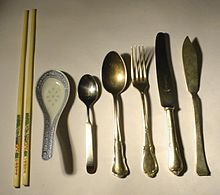Table manners

Among the table manners means the etiquette at the table , more precisely in taking of food and beverages in society.
history

The diet sociology dealing scientifically with table manners, eating habits and drinking culture . According to Norbert Elias , European table manners developed in the process of civilization , in which external constraints increasingly became self-constraints. Bourdieu looks in the table manners unincorporated cultural capital , with the privileged classes from other means of fine differences distinguieren .
According to Ulrich Tolksdorf, table manners developed in three phases:
- The Middle Ages , when people ate largely without rules and with bare hands,
- a second phase between the 16th and 18th centuries, in which a comprehensive code of conduct was formed,
- a third phase in the 19th and 20th centuries, in which the standard achieved was only slightly changed.
In addition to table manners, courtesy and manners are also taught in the so-called etiquette . However, Adolph Freiherr Knigge was less concerned with table manners than is often assumed .
Reasons for table manners
Table manners represent a code of conduct, which serves to make the joint enjoyment of food as pleasant as possible for all those present by avoiding annoying noises and sights. Adhering to table manners demonstrates consideration and appreciation.
Examples of table manners in Western Europe and the USA
General
Ingesting large portions in the mouth and speaking with your mouth full should be avoided. Loud eating noises, burps and clinking of cutlery and crockery are frowned upon. Apart from bread, food is only touched with the fingers if this is expressly specified by the host. Finger bowls with water and lemon are then usually provided to clean the fingers. An upright and straight posture shows the table partners interest and respect. This posture is also maintained while eating, so that the food is brought to the mouth and not the mouth to the plate. Placing your elbows on the table should be avoided. Both the beginning and the end of a meal and its removal from the table are initiated by the hostess.
Handling the cutlery
Knives, forks and spoons should not be wrapped in your fist, but treated in a similar way to handling a writing instrument. Knife and fork are placed crossed at the tips on the plate if there is a break during the meal. If a knife and fork are placed parallel to each other on the plate, it signals that you have finished your meal. Used cutlery must not be placed on the table. Gesturing with the cutlery in hand is also not part of good table manners. It is not important in which hand the fork and in which the knife is, most of the time you hold the knife in your right hand if you are right-handed.
The zigzag method is widespread in the USA : you first hold a knife and fork like a European. After you have cut off a piece of the food, you put the knife down, the fork goes into your right hand and pushes the food into your mouth. Then she wanders to the left again. Many people cut their food into bite-sized pieces. Then the left hand has nothing more to do and goes under the table. The zigzag method emerged as a custom in France in the early 18th century, and the Americans followed suit. When the Europeans turned around around 1850, the custom was retained in the USA.
Handling the napkin
Regardless of whether cloth or paper napkins are on display, they are intended exclusively for the lips. These should be dabbed off before the glass is used to avoid the edges of grease, lipstick or food on the glass. Napkins are placed on your lap and are not used as a bib substitute. When the meal is over, the napkin should be placed on the left of the plate.
See also
- Table culture in the Roman Empire
- Table manners in the Middle Ages
- Seating arrangements | Table setting | Cutlery
literature
- Norbert Elias: About the process of civilization , sociogenetic and psychogenetic studies . 2 volumes, 32nd edition, Suhrkamp, Frankfurt am Main 2013 (first edition 1932), ISBN 3-518-27758-8 (Volume 1: Changes in behavior in the secular upper classes of the West ); ISBN 3-518-27759-6 (Volume 2: Changes in society, draft for a theory of civilization ).
- Thomas Schürmann: Table and greeting customs in the civilization process . (= Contributions to popular culture in north-west Germany; 82). Waxmann, Münster et al. 1994, ISBN 3-89325-233-9 ( full text as PDF )
- Ulrich Tolksdorf: Food research . In: Rolf W. Brednich (Hrsg.): Grundriss der Volkskunde. Introduction to the research fields of European ethnology . Berlin 1994.
Web links
- Food culture on www.magellanworld.net
- Table manners in antiquity
- Table manners in Germany on knigge.de
Individual evidence
- ↑ Tolksdorf 1994, p. 240
- ↑ a b zeit.de: That's right / US eating manners
